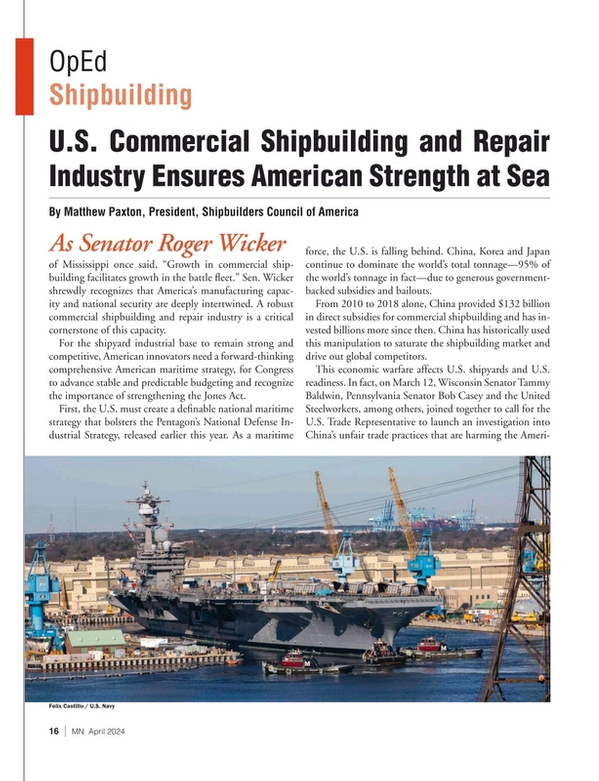
OpEd: US Commercial Shipbuilding and Repair Industry Ensures American Strength at Sea
As Senator Roger Wicker of Mississippi once said, “Growth in commercial shipbuilding facilitates growth in the battle fleet.” Sen. Wicker shrewdly recognizes that America’s manufacturing capacity and national security are deeply intertwined. A robust commercial shipbuilding and repair industry is a critical cornerstone of this capacity.
For the shipyard industrial base to remain strong and competitive, American innovators need a forward-thinking comprehensive American maritime strategy, for Congress to advance stable and predictable budgeting and recognize the importance of strengthening the Jones Act.
First, the U.S. must create a definable national maritime strategy that bolsters the Pentagon’s National Defense Industrial Strategy, released earlier this year. As a maritime force, the U.S. is falling behind. China, Korea and Japan continue to dominate the world’s total tonnage—95% of the world’s tonnage in fact—due to generous government-backed subsidies and bailouts.
From 2010 to 2018 alone, China provided $132 billion in direct subsidies for commercial shipbuilding and has invested billions more since then. China has historically used this manipulation to saturate the shipbuilding market and drive out global competitors.
This economic warfare affects U.S. shipyards and U.S. readiness. In fact, on March 12, Wisconsin Senator Tammy Baldwin, Pennsylvania Senator Bob Casey and the United Steelworkers, among others, joined together to call for the U.S. Trade Representative to launch an investigation into China’s unfair trade practices that are harming the American industrial base.
Second, the Congress must prioritize stable and predictable budgets rather than short-term funding stop gaps that allow for the shipyard industry to plan for investments in their infrastructure and workforce. Inconsistent funding signals create uncertainty in future operation plans, and to train, advance and retain the most valuable asset in our industrial base—our skilled workforce—we need that certainty, like any business sector.
On the commercial side, consistent policy signals for new maritime markets, such as the Biden Administration’s push for offshore wind, are essential for the industrial base to plan and construct for these exciting new opportunities. As with any industry or supply chain that will support a burgeoning innovation for a new market, funding is critical, but without long-term policy and cross-sector operationalization plans, investment in these markets becomes significantly more difficult.
Third, the fundamental maritime national security law—the Jones Act—must remain the foundation of the U.S. maritime strategy. Per the Maritime Administration (MARAD), the U.S. shipbuilding industrial base creates a workforce of nearly 400,000, generates $28.1 billion of labor income and contributes $42.4 billion in GDP. These are good family-waged jobs in all 50 states and communities across the nation. In fact, in many communities in regions like the Gulf states, the shipyard industrial base is the leading economic engine, employing generations of families.
There are 125 yards engaged in building, repairing, repowering and maintaining ships, not to mention the massive supply chain that supports those yards. This capacity has not been outsourced like many other critical manufacturing sectors, like semiconductor manufacturing, largely thanks to the Jones Act.
Disturbingly, special interest groups and foreign-funded think tanks are actively attacking the U.S. maritime industry and the Jones Act. Their short-sighted, greed-driven policies seek to outsource this critical manufacturing sector for cheap foreign labor and shoddily-built Chinese ships. This would be disastrous for our maritime security and would decimate jobs in local communities at a time in which our maritime strength is needed more than ever during geopolitical unrest.
Without a strong, forward-thinking comprehensive American maritime strategy, advancing predictable budgeting and other market-building policies and strengthening the Jones Act, other nations like China will continue to invest in their commercial and military maritime capacity and will continue to overtake us as the world’s maritime leader.
A flourishing shipyard industrial base is not just an investment in our national and economic security future but a safeguard for generations to come.
Read OpEd: US Commercial Shipbuilding and Repair Industry Ensures American Strength at Sea in Pdf, Flash or Html5 edition of April 2024 Marine News
Other stories from April 2024 issue
Content
- US Inland Waterways: Economic Impact by State page: 08
- Insights: Jennifer Carpenter, President & CEO, American Waterways Operators page: 10
- OpEd: US Commercial Shipbuilding and Repair Industry Ensures American Strength at Sea page: 16
- The Maritime Industry Has Unique Cybersecurity Challenges page: 18
- Navigation and Wind Farms: Competing Ocean Uses Raise Existential Questions page: 20
- Marine News' 2024 US Shipbuilding Report page: 26
- On Board the eWolf: The First Electric Tugboat in the US page: 32
- Optimizing Blast and Paint Processes in New Construction Shipbuilding page: 38


